All about krinum: types, planting and care

Flowering crops have always been in special favor with florists and florists who are engaged in the design of homes and public spaces, as well as personal plots and park areas. Krinum refers to plants that are able to decorate with their flowering any flower bed or house. Due to the variety of species, the flower is in demand as an ornamental plant that can be grown and propagated on its own.

general description
Bulbous culture belongs to the genus Amaryllis, in its natural environment the flower grows in the humid tropics and subtropics. Very often, krinum can be found on the coast of seas, rivers, lakes, as well as in an area that, due to the specific climatic conditions, is periodically subject to flooding. The name of the culture is translated from Latin as "hair". And the flower is named in a similar way due to the specific structure of the green mass.
The leaves of the krinum are quite long, depending on the species, they have a linear or xiphoid shape, hanging from the culture, they really resemble hair. Crinum leaves can be up to one and a half meters long. Young leaves will first be rolled into a tube.


The bulbous rhizome can reach a length of half a meter to a meter, while the diameter is no less expressive and is 20-25 centimeters. As for the peduncle, it is of medium size, and an umbrella-type inflorescence is formed at its end.
The culture blooms mainly with monophonic flowers, the color of which varies depending on the variety. Most often, you can find garden krinum with pink or white flowers. The flowers have some similarity with bells or lilies due to the structure of their petals, which are collected in inflorescences of 15-20 pieces.
Krinum is perennial, and subject to the cultivation of the plant in nutrient soil you can enjoy the flowering of a bulbous plant for at least 10 years. It enters the flowering phase with the arrival of spring, continuing to bloom until autumn.

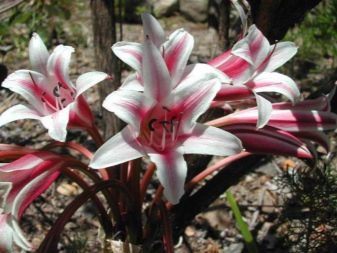
After flowering, the culture bears fruit, in this case, the seed box, containing rather large seeds, acts as the fruit of the flower. The impressive size of the seeds is associated with the content of a large amount of liquid under their shell, thanks to which, rooted by humans or naturally, they retain their viability in any conditions, even without moisture.
The flower is very often used not only for planting in open ground, but also as a houseplant.... Krinum becomes a decoration for various public spaces, where temperatures remain low throughout the year. In addition, the crop is successfully cultivated in apartments and houses. Today there are types of bulbous plants that are grown in aquariums.


Krinum is in demand in folk medicine, almost all parts of the plant are used for the preparation of medicinal compositions.
Views
Krinum has two forms:
- home culture;
- garden.


Plants from the first group can be grown in cool rooms, garden varieties are intended for cultivation in the open field. Today you can find varieties of krinum that winter in flower beds, but for this, gardeners mulch the soil in the fall.
With the arrival of cold weather, the entire aerial part of the flower dies off, and the bulbs remain in the ground until the arrival of spring.In the natural environment, there are several hundred varieties of plants, about two dozen are successfully grown by gardeners, and only three types of bulbous crops can be cultivated indoors. Among the most popular varieties are the following plants.


Crinum moorei
Indoor species, which has a second name - "pink lily". The flower has a large root bulb with a neck emerging from the ground, which many mistake for the stem of a flower. The foliage of Moore's krinum is belt-like with a wavy edge, the length varies from half a meter to one meter. The flower-bearing part is formed near the neck, at its end buds develop, resembling a lily, which can have an open diameter of up to 12 centimeters.
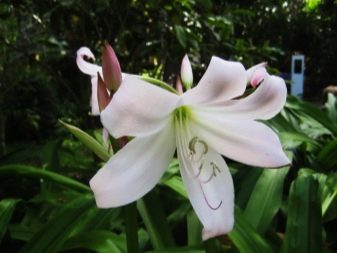

Crinum asiaticum
This variety has a small bulb in comparison with other indoor flowers. The neck reaches a length of about 30 centimeters. The foliage is collected in a bunch. The leaves can be up to one meter long and only 10 centimeters wide. The inflorescence can contain from 2 to 50 flowers, the formation of which occurs on long tubular peduncles. The color of the buds of the Asian krinum is white, while the stamens inside are painted in red shades.

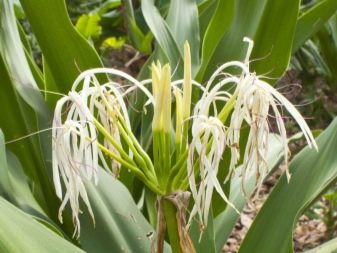
Crinum jagus
The indoor flower stands out for its decorative appearance. The bulb reaches 10-15 centimeters in diameter, the neck grows about the same size. The leaves are wavy along the edge, their length can reach up to a meter, there are bright veins inside. The peduncle is quite high - about a meter. The flowers are large with white petals, similar to the Powell hybrid and bell-shaped throat. The culture only blooms during the summer months.


Crinum campanulatum
Garden type with long pointed leaves. On a thin peduncle, 5-8 flowers develop on small pedicels, the length of which is only a couple of centimeters. The petals at the base are white with red stripes, towards the edges the color gradually turns into pink and green.

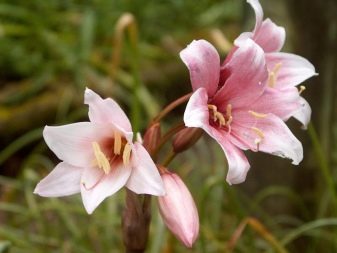
Crinum erubescens Aiton
A culture with a small bulb and belt-like leaves that grow no more than 80-90 centimeters and a width of 5-8 centimeters. One of the characteristics of the plant is the roughness of the back of the green mass. With small leaf sizes, krinum have long peduncles, they usually have about 5-6 buds. The petals are red on the outside, and white on the inside.


Crinum platense
On the flower, from 6 to 10 leaves of a linear shape are formed, their length is not more than 60 centimeters. The peduncle is half shorter than the leaves. The umbrella-type inflorescence contains 5 to 10 flowers with small 1.5 cm petals.


Crinum purpurascens
The culture has a small egg-shaped bulb and 30-centimeter leaves, with a peduncle of the same length. At its end, from 5 to 10 flowers are formed, arranged in the form of umbrellas. The petals are purple in color, flowering can occur at any time of the year, very often the flower is rooted in water bodies, since the lower part of the plant is not afraid of decay.


Crinum calamistratum
Curly Kalamistratum, like Thai (Thai), is grown in an aquarium. The plant has an elongated 10 cm long bulb. The leaves resemble ribbons, their length can vary from 50 centimeters to 2 meters, with a width of 0.2-0.7 centimeters. The floating peduncle is straight, 2-3 flowers in white tones are formed on it. The optimum height of the water column for a culture in an aquarium is half a meter.

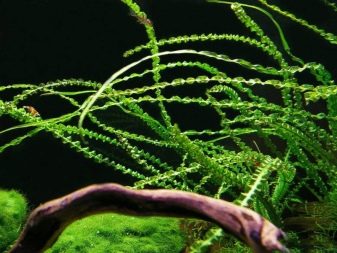
Crinum natans Baker
In the wild, the plant grows in streams and rivers with good flow. The culture is large, the leaves are in the form of ribbons with a width of about 5 centimeters. Usually the foliage of krinum is curly, but there are plants with flat foliage. The flower is propagated by daughter bulbs. Can be used for growing wabi-kuse in aquariums together with Natans variety.

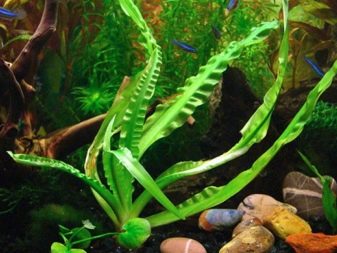
Home content
Krinum is drought tolerant, so irregular watering will not affect crop growth in any way. Very often, inexperienced flower growers begin to grow flowers at home from krinum. However, most species of this plant look attractive only in the warm season, which must be taken into account when choosing a suitable place for placement.
In winter, the culture will be in a dormant phase, therefore standard care measures will need to be adjusted... There are a number of basic nuances regarding indoor bulb care.

Lighting
Krinum refers to light-loving and sun-loving flowers, the plant is not afraid of direct sunlight, therefore, the most sunny and lighted windowsills will be the preferred place for growing. It is best that the windows, where the flower will grow, face south.
The culture can be exposed to light all year round, including the resting phase. As an alternative to natural light, crinum is very often grown in rooms with full supplemental phytolamps. This also applies to aquarium varieties. Using this method, it will be possible to provide a 15-16 hour daylight hours for a flower.

Air temperature
Most of the species are thermophilic crops, therefore, the lower limit of the temperature regime for them is + 14C, however, there are indoor varieties that tolerate a decrease even to -6C well. During the growing season, the plants will develop well in a room warmed up to + 22C, in winter it is recommended to keep the flower cool by reducing the indicators to + 18C.
In summer, the plant can be temporarily transferred to a balcony, terrace or garden. The flower endures a change of place and is not afraid of drafts.


Air humidity and irrigation
Regular and abundant watering of the krinum will be needed during the flowering period and the growth of green mass. If the top layer of soil in the pot has become dry, then the culture must be watered... At the end of flowering, moisture can be gradually reduced, thereby preparing the flower for the resting phase.
In winter, it is necessary to moisten the flower, but watering should not be frequent and abundant. The frequency of moisture directly affects the flowering of the crop, so the florist can adjust the timing at his discretion, shifting the wintering. The main thing is to prevent the green mass from wilting: if the tips of the leaves of the plant turn yellow, it is worth adjusting the introduction of moisture. Watering the krinum is necessary with a warm, settled liquid.

As for the humidity of the air, the bulbous flower does not need to create any specific conditions, however, it is necessary to constantly wipe the leaves of the flower from dust.
Fertilizer
The culture responds positively to the introduction of top dressing. As a rule, it is carried out once a week during the growth and flowering of krinum. When old foliage withers, feeding can be stopped. To maintain plant growth, it is recommended to use complex mineral compositions intended for indoor flowering crops.

Pruning and rejuvenation
The flower will need pruning in order to increase its decorative appeal by removing faded inflorescences and dried foliage. Also, these activities will help the culture grow new greenery.

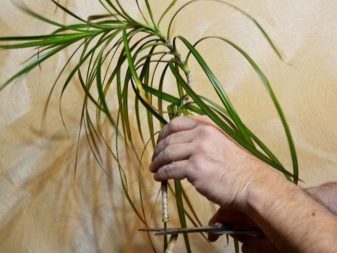
Transfer
Often there is no need to change the container in which the krinum grows. As a rule, growers change the pot and substrate of an indoor flower once every 2-3 years. These activities are recommended to be carried out at the end of wintering and rest of the culture, but before the start of its active development and growth.
A bulbous plant can grow in any soil, even if there is soil from the garden in the pot. However, experienced growers prefer to use special universal soil mixture for amaryllis cropswhich will have good aeration.

You can prepare the soil for planting krinum yourself, for this you should mix sand, humus, deciduous soil... During transplantation, it is necessary to inspect the plant bulb for damage, remove dry roots and films. When rooting the crinum in a new container, place it so that the bulb is one third above the ground.
There should be drainage at the bottom of the pot. The capacity should be wide, since aerial roots are formed in the bulbous culture.
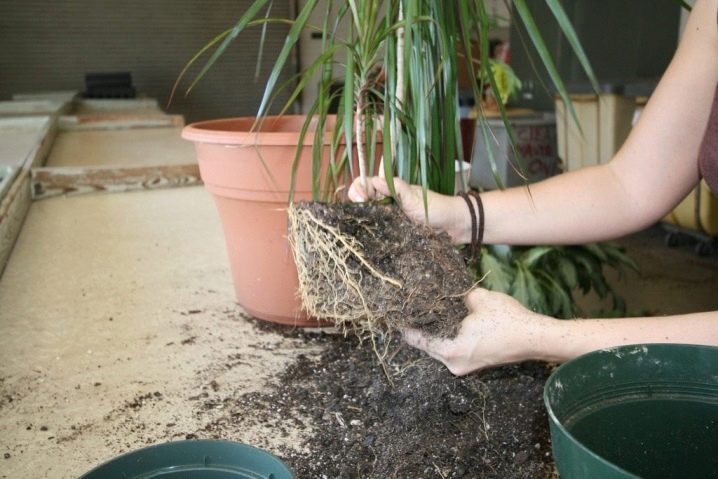
Reproduction methods
You can get a new culture at home by separating daughter plants or by growing it from seeds. In the latter option, it will be possible to preserve all the varietal characteristics of the crop, however, seeds can only be obtained after artificial pollination of the flower.
The collected material is rooted in a moist substrate, with the obligatory covering of the container with film or glass. Daughter bulbs are usually removed at the time of transplanting the krinum - at this time many young crops can be separated from the mother plant. The separated bulbs are rooted in small containers, the diameter of which should not exceed 12 centimeters. Young plants will be able to bloom no earlier than in 2-3 years. As they grow, they will need to be transplanted into larger containers.
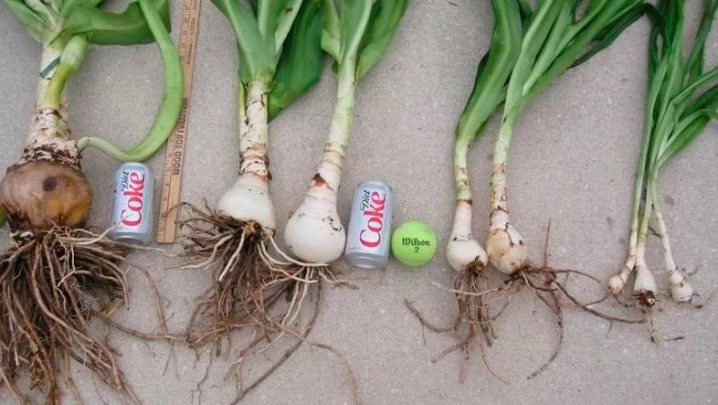
Planting and care in the open field
For flowering and proper development of krinum in the garden, it is necessary to find the right place for rooting for it. The flower will bloom only in the sun, so it should not be planted in the shade. The place should be spacious, so that the plant does not have obstacles to the development of the aboveground and underground parts. The south and east sides of the garden will be a good option for krinum, but draughty areas are recommended to be avoided.

It is more correct to choose a flower bed located on a small hill. Planting in open ground should be carried out in April-May, the day before the soil should be fertilized with ash. In one place, a flower can grow for about 4 years. If you plan to plant several crops on a flower bed, then the distance between the flowers should be at least 30 centimeters.
Watering
In order for the culture to bloom in the garden, the plant must be constantly watered - moisture will provoke the formation of buds on the peduncle. It is not worth pouring the flower heavily, the main thing is that the soil is moist. Excessive dampness can adversely affect the health of the bulb, which can begin to rot.
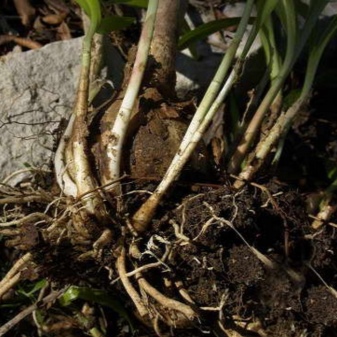
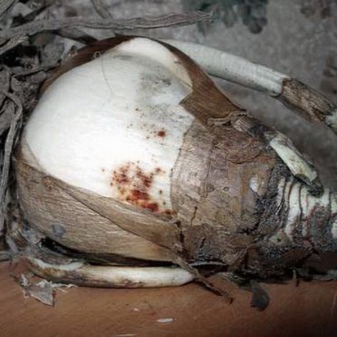
Fertilizer
It is recommended to regularly feed Krinum outdoors. To do this, the gardener should use liquid fertilizers twice every 7-10 days. For the proper development of bulbous culture in the garden, it is worth alternating mineral fertilizing with organic matter.

Manure or dung diluted in water can be used as organic fertilizers. Before the culture blooms, it should be fed with potassium salt or superphosphate.
Wintering
It is possible to determine that the plant is entering a dormant phase by the green mass - it gradually turns yellow and dies off. In the garden, the krinum is sheltered during cold weather under a layer of peat or straw. In order for the plant to retain its vitality, the layer of mulch should not be less than 50 centimeters. In the spring, the protection is removed. In regions with a harsh climate, garden krinum is dug out of flower beds for the winter and stored in the refrigerator until the heat arrives.
Another option for wintering the bulb culture is to temporarily transplant it into a container that is placed in a cool room throughout the winter, providing the bulbs with regular moisture. It is also recommended to move pots with flowers for the winter to a room where the air temperature does not drop below + 5C.
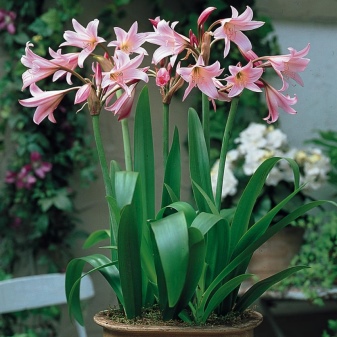

Diseases and their treatment
The culture rarely suffers from diseases and pest attacks. However, the danger to the flower is a red burn - stagonosporosis. The disease affects the aerial part of the krinum, gradually moving to the bulb. A plant should be treated for such an ailment drug "Fundazol"by carrying out the processing of the culture. In case of severe damage, it is recommended to coat the plant composition based on chalk, copper sulfate and OP-7 adhesive.
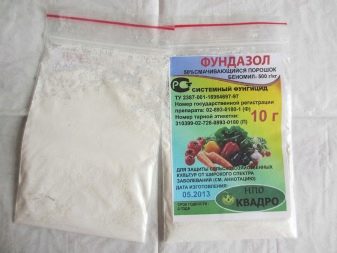

Soot fungi can also appear on the plant. They are fought with liquid insecticides.
See below for more details.























The comment was sent successfully.